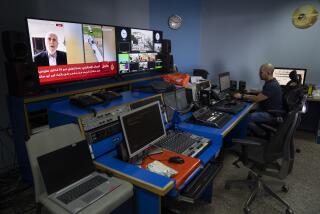CNN Crew Draws Fire and, Later, Criticism
- Share via
NEW YORK — It was a war correspondent’s worst fear: CNN reporter Brent Sadler and his crew found themselves coming under heavy fire while in Tikrit on Sunday. An armed guard traveling with the team -- which had entered Saddam Hussein’s hometown ahead of U.S. military forces -- fired back, and more than 100 rounds were exchanged before the reporters got away safely.
“OK, that’s gunfire,” Sadler said on live TV as the incident began. “We’re just under attack. Under attack. We’re OK, we’re OK.” Seconds later, as the CNN convoy sped away from the gunmen, he added with relief: “I think that’s as far as we’re going to push it today.”
The dramatic footage was aired repeatedly through the day, but in the aftermath some media observers questioned whether the CNN team had crossed what has traditionally been a clear line between the military, which wages war, and journalists, who are supposed to be noncombatants.
Some critics suggested that reporters lose the presumption of neutrality if they become involved in combat. Yet others said journalists have increasingly come under fire in combat situations all over the world -- and that traveling with armed guards may be necessary.
“CNN appears to be going too far,” Jean-Francois Julliard, a spokesman for Reporters Without Borders, said in a statement.
“This behavior creates a dangerous precedent.... There is a real risk now that belligerents will believe all press vehicles are armed,” added Robert Menard, the group’s secretary-general.
Julliard said Sunday’s incident in the Iraqi city represented the first time that media vehicles had traveled in combat with private, armed security guards, noting that journalists did not employ such personal protection during the Balkan and the 1991 Persian Gulf wars.
They did, however, use armed guards during the conflict in Somalia, said Joel Campagna, the Mideast program coordinator for the Committee to Protect Journalists, which is based in New York.
“We take a more neutral stance on incidents like the one with CNN,” he said. “Any time you carry arms or are traveling with armed guards you abandon the perception that you are a noncombatant, which is very important for journalists. But we would never say that you have to sacrifice your own security, if that is what a particular reporting situation calls for.”
In Sadler’s case, he added, “you clearly had to react quickly, to avoid getting killed.” Twenty reporters were killed worldwide last year, most of whom were slain in reprisal attacks because of their work, Campagna noted. Although the committee has adopted a code of conduct for reporters in wartime, he added, it does not take a position on the use of armed guards.
Nine journalists have died in the Iraq war zone, including Washington Post columnist Michael Kelly. Another American, NBC correspondent David Bloom, died of a pulmonary embolism while reporting from there. A BBC translator also died.
“Historically, journalists have been able to respect the notion that they are not part of a conflict and will not be attacked,” said Tom Rosenstiel, director of the Project for Excellence in Journalism.
“But those niceties are not being observed the way they used to be, and so the question of what’s the right approach for a reporter gets muddled.”
Sadler, whose team came under gunfire during the end of a two-hour report from Tikrit, was traveling in a two-vehicle convoy that had been marked with a “TV” sign, a well-known international symbol for the media, according to Matt Furman, a CNN spokesman.
Sadler and other so-called unilateral reporters -- who move about on their own and are not traveling with military forces -- have experienced weeks of dangerous reporting conditions in northern Iraq, Furman added.
“It clearly made sense to have our reporters protected in any way they can, with armed guards,” Furman said. “But it’s important to note that our reporters were not at any time armed themselves.”
A Pentagon official said “it remains incredibly dangerous to be out there as a unilateral journalist.”
More to Read
Sign up for Essential California
The most important California stories and recommendations in your inbox every morning.
You may occasionally receive promotional content from the Los Angeles Times.










